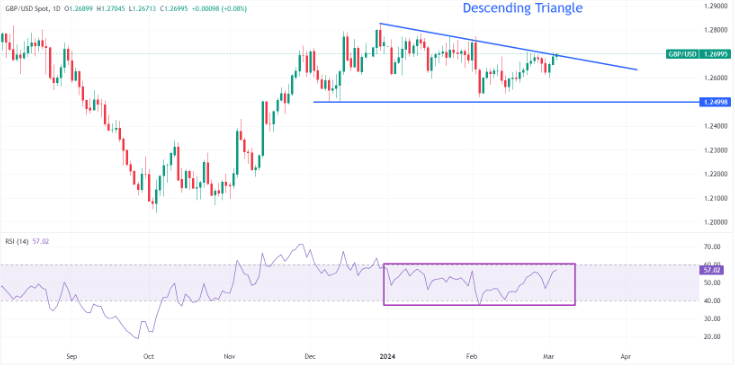- Amid market caution preceding the UK’s budget and Fed Powell’s testimony, Pound Sterling experiences a decline.
- A restrained inclusion of fiscal stimulus in the UK’s spring budget would bolster expectations for potential rate cuts by the Bank of England.
- Market participants anticipate the release of US PMI data to gain fresh guidance.
During Tuesday’s European session, the Pound Sterling (GBP) experienced a modest decline from the critical resistance level of 1.2700. The GBP/USD pair faced downward pressure attributed to a waning investor risk appetite and uncertainties surrounding the upcoming United Kingdom Spring budget, scheduled to be presented by Chancellor Jeremy Hunt on Wednesday.
The challenge for Jeremy Hunt lies in striking a balance with fiscal measures, given the persistent inflation concerns and declining growth projections in the UK. According to BBC News, Hunt stated on Sunday, “We’ve always said we would only cut taxes in a way that’s responsible and prudent.”
If the budget reveals limited room for tax cuts, it could intensify expectations of early rate cuts by the Bank of England (BoE), potentially weighing on the Pound Sterling.
Concurrently, the prevailing negative market sentiment ahead of Federal Reserve Chair Jerome Powell’s congressional testimony on Wednesday, coupled with a series of economic data releases in the United States this week, has provided some support for the US Dollar.
In today’s trading session, investors will closely monitor the release of the US S&P Global and ISM Services PMIs at 14:45 GMT and 15:00 GMT, respectively.
Market Digest: Pound Sterling Faces Decline Following Downbeat UK Service PMI
- Pound Sterling retreats from the pivotal resistance level of 1.2700 amidst cautious sentiment preceding the United Kingdom’s Spring budget and a busy economic calendar in the United States.
- Investors will closely scrutinize Chancellor Jeremy Hunt’s announcement of the Spring budget. Any signals of increased fiscal stimulus, such as tax cuts, reductions in national insurance rates, and substantial public spending initiatives without corresponding revenue-raising measures, could dampen expectations of early rate cuts by the Bank of England. Such fiscal stimulus may contribute to inflationary pressures.
- The anticipated strategy of the Conservative government is inclined towards stimulating growth to prevent the economy from slipping into another recession. Nevertheless, the expectation is not for a substantial stimulus package.
- Bank of England (BoE) policymakers have suggested that the technical recession experienced in the latter part of 2023 was of a modest nature.
- The economy appears to be regaining momentum with notable improvements in Retail Sales and PMIs. Nevertheless, a variety of liquidity measures is deemed necessary to ensure that the recovery path of the economy remains on course and is not derailed.
- Conversely, the restricted nature of fiscal measures might increase the likelihood of early rate cuts by the Bank of England (BoE). Market expectations point towards the possibility of the BoE initiating interest rate reductions in August, aligning with the anticipated return of inflation to the 2% target before a subsequent rise.
- Meanwhile, the S&P Global/CIPS has released disappointing Services PMI data for February, indicating a drop to 53.8 from both expectations and the previous reading of 54.3.
- The US Dollar retreats to a two-day low, hovering around 103.70 in anticipation of Federal Reserve Chair Jerome Powell’s congressional testimony on Wednesday. Market focus also centers on various upcoming US economic data releases, including the ISM Services PMI, ADP Employment Change, JOLTS Job Openings, and the Nonfarm Payrolls.
- Powell is anticipated to caution against the potential hazards associated with premature rate cuts, emphasizing the necessity for additional evidence to affirm the return of inflation to the 2% target.
Technical Analysis: Pound Sterling advances to 1.2700

The Pound Sterling is making a notable effort to convincingly breach the descending trendline of the Descending Triangle pattern established on the daily time frame, originating from the high on December 28 at 1.2827. A decisive breakthrough above this trendline may trigger a substantial upward surge. The horizontal support of this pattern is derived from the low recorded on December 13 near 1.2500.
A Descending Triangle pattern typically reflects a sense of indecision among market participants, with a slight inclination toward the downside due to lower highs and a horizontal lower boundary. The 14-period Relative Strength Index (RSI) demonstrates oscillations within the 40.00-60.00 range, pointing towards a notable contraction in volatility.
